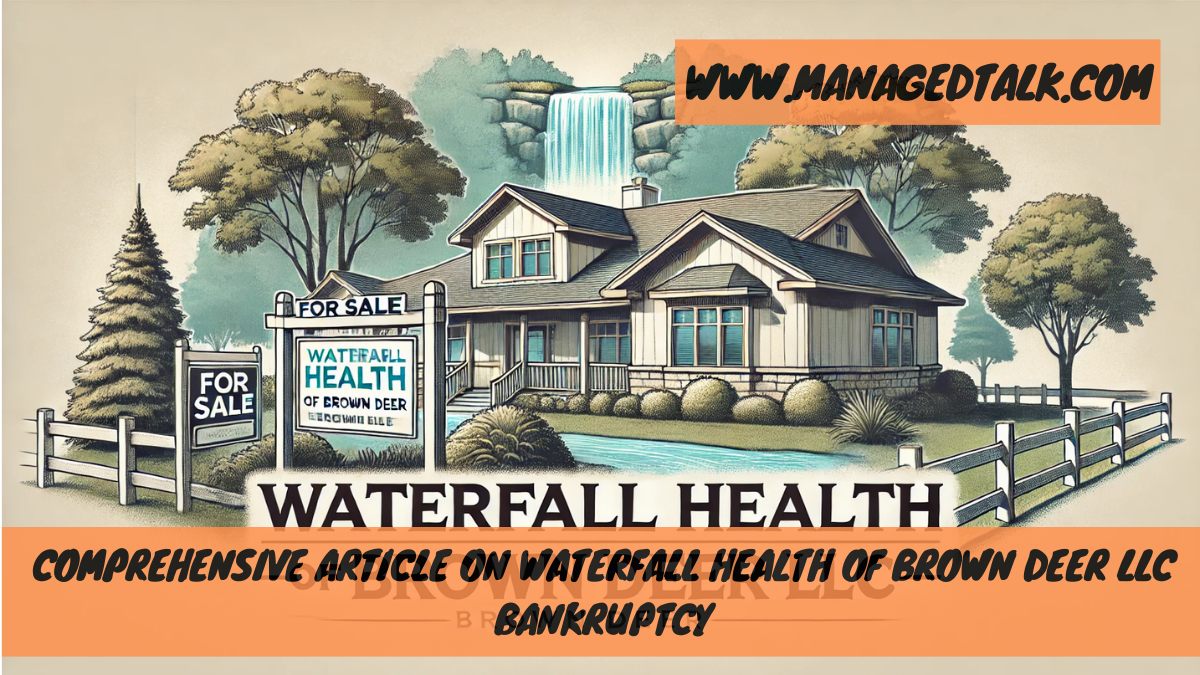Introduction
The bankruptcy of Waterfall Health of Brown Deer LLC has sparked conversations within the healthcare sector and the broader community. Known for providing quality healthcare services and a strong commitment to patient care, its sudden financial decline came as a surprise to many.
Waterfall Health of Brown Deer LLC faced bankruptcy despite its commendable community services and patient care, impacting the healthcare landscape in Brown Deer and prompting questions about healthcare sustainability.
This comprehensive article delves deep into the reasons behind the bankruptcy, its impact on the community, related financial intricacies, and lessons that can be drawn for future healthcare operations.
1. Background of Waterfall Health of Brown Deer LLC
Waterfall Health of Brown Deer LLC has been a vital healthcare provider in Brown Deer, Wisconsin. Established to meet the needs of the local population, it quickly garnered a reputation for its high standard of patient care and community service. The facility was appreciated for its dedicated staff, advanced medical services, and its proactive approach to health and wellness. Despite these strengths, the company faced challenges that ultimately led to its financial downfall.
Key Services Offered
- Comprehensive outpatient and inpatient care
- Specialized treatment programs
- Rehabilitation and senior care services
2. The Factors Leading to Bankruptcy
The bankruptcy of Waterfall Health of Brown Deer LLC did not occur overnight. Several factors contributed to this crisis, including financial mismanagement, rising operational costs, and shifts in healthcare policies. Let’s break down these challenges:
a. Financial Mismanagement
Poor budgeting and financial oversight were significant contributors. While the organization focused heavily on enhancing patient care and expanding its services, it failed to establish a robust financial structure. This resulted in unmanageable debt levels.
b. Increased Operational Costs
Healthcare providers face escalating costs, from medical supplies to staff wages. The inflation of healthcare-related expenses placed a heavy burden on Waterfall Health’s finances, limiting its ability to sustain itself.
c. Policy and Insurance Complications
Changes in healthcare policies, reimbursements, and insurance negotiations often pose obstacles for providers. The financial pressure increased as insurance claims became harder to process, leading to cash flow issues.
d. Community Challenges
Brown Deer, like many small American towns, has faced its own economic difficulties. The financial health of local residents impacted the number of patients able to afford healthcare services, further straining the facility’s revenue.
3. Impact of the Bankruptcy on the Community
The announcement of Waterfall Health of Brown Deer LLC’s bankruptcy was met with widespread concern. The community relied on the facility for its high-standard medical care and wellness programs. The sudden loss of such an essential institution created a vacuum, affecting many residents who depended on its services for health management.
Immediate Effects
- Patient Displacement: Patients had to find alternative healthcare providers, which often meant traveling further distances or dealing with longer wait times at neighboring facilities.
- Employment Losses: The bankruptcy resulted in job losses for a significant number of healthcare professionals, affecting their livelihoods and the local economy.
4. Analyzing the Financial Collapse: A Detailed Insight
The financial documentation revealed that the company had been struggling for a longer period than initially thought. This analysis provides insight into the patterns of revenue generation, expenditure, and mismanagement that culminated in the bankruptcy.
a. Inadequate Revenue Generation
The facility did not diversify its revenue streams effectively. While government programs and insurance reimbursements were primary sources, delays in these payments left gaps in financial stability.
b. Rising Debt Levels
Loans and financial liabilities accrued over time without strategic repayment plans. This created a cycle where the organization borrowed more to cover previous debts, ultimately leading to financial insolvency.
c. Legal and Compliance Costs
The facility’s operations included significant costs related to legal compliance and medical regulations. Failure to meet certain compliance standards brought fines and additional expenses that exacerbated the financial crisis.
5. Lessons Learned for Future Healthcare Providers
The bankruptcy of Waterfall Health of Brown Deer LLC serves as a cautionary tale. Here are some crucial takeaways:
a. Strong Financial Planning
Healthcare institutions must prioritize robust financial management practices. Regular audits, budgeting, and strategic planning can help mitigate risks.
b. Adaptive Policies
Being adaptable to changes in healthcare laws and policies is essential. Providers should stay proactive in negotiating insurance contracts and securing alternative funding sources.
c. Community Engagement
Providers must maintain strong community ties and collaborate with local organizations to foster support. Engaging in public health initiatives can secure long-term loyalty and funding.
d. Diversifying Income
Implementing varied services, partnerships, and fundraising efforts can help create multiple streams of revenue, ensuring greater financial security.
FAQs
1. Why did Waterfall Health of Brown Deer LLC file for bankruptcy?
Waterfall Health faced bankruptcy due to financial mismanagement, rising operational costs, policy complications, and an inability to adapt to shifting economic conditions.
2. How has the bankruptcy impacted the local community?
The bankruptcy has displaced patients who relied on the facility, increased the demand on neighboring healthcare services, and resulted in job losses among healthcare professionals.
3. What financial lessons can be learned from this case?
Key lessons include the importance of strategic financial planning, staying adaptable to policy changes, and diversifying income sources to build financial resilience.
4. Could the bankruptcy have been avoided?
With better financial oversight, debt management, and adaptive strategies, it’s possible that the bankruptcy might have been averted or mitigated.
5. What’s next for Brown Deer’s healthcare landscape?
New partnerships and investments from external healthcare providers may fill the void left by Waterfall Health. Community advocacy will play a role in shaping the future of local healthcare.
Conclusion
The bankruptcy of Waterfall Health of Brown Deer LLC serves as a reminder of the delicate balance between healthcare service excellence and financial sustainability. While its dedication to patient care was commendable, financial mismanagement and a failure to adapt ultimately led to its downfall. Moving forward, other healthcare providers can learn valuable lessons from this case to ensure their longevity and continued community service.
